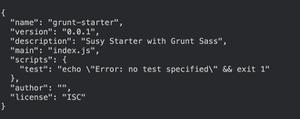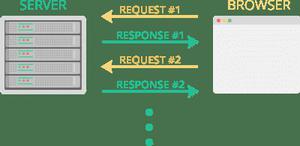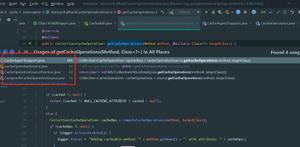spring boot使用WebClient调用HTTP服务代码示例
这篇文章主要介绍了spring boot使用WebClient调用HTTP服务代码示例,文中通过示例代码介绍的非常详细,对大家的学习或者工作具有一定的参考学习价值,需要的朋友可以参考下
WebClient的请求模式属于异步非阻塞,能够以少量固定的线程处理高并发的HTTP请求
WebClient是Spring WebFlux模块提供的一个非阻塞的基于响应式编程的进行Http请求的客户端工具,从Spring5.0开始提供
在Spring Boot应用中
1.添加Spring WebFlux依赖
<dependency>
<groupId>org.springframework.boot</groupId>
<artifactId>spring-boot-starter-webflux</artifactId>
</dependency>
2.使用
(1)Restful接口demoController.java
package com.example.demo.controller;
import com.example.demo.domain.MyData;
import org.springframework.http.HttpHeaders;
import org.springframework.http.MediaType;
import org.springframework.web.bind.annotation.*;
import javax.servlet.http.Cookie;
import javax.servlet.http.HttpServletRequest;
@RestController
@RequestMapping("/api")
public class demoController {
@GetMapping(value = "/getHeader", produces = {MediaType.APPLICATION_JSON_UTF8_VALUE})
public MyData getHeader(HttpServletRequest request) {
int id = 0;
if (request.getParameter("id") != null) {
id = Integer.valueOf(request.getParameter("id"));
}
String name = request.getParameter("name");
//header
String userAgent = "USER_AGENT——" + request.getHeader(HttpHeaders.USER_AGENT);
userAgent += " | ACCEPT_CHARSET——" + request.getHeader(HttpHeaders.ACCEPT_CHARSET);
userAgent += " | ACCEPT_ENCODING——" + request.getHeader(HttpHeaders.ACCEPT_ENCODING);
userAgent += " | ContextPath——" + request.getContextPath();
userAgent += " | AuthType——" + request.getAuthType();
userAgent += " | PathInfo——" + request.getPathInfo();
userAgent += " | Method——" + request.getMethod();
userAgent += " | QueryString——" + request.getQueryString();
Cookie[] cookies = request.getCookies();
if (cookies != null) {
for (Cookie cookie : cookies) {
System.out.println(cookie.getName() + ":" + cookie.getValue());
}
}
MyData data = new MyData();
data.setId(id);
data.setName(name);
data.setOther(userAgent);
return data;
}
@PostMapping(value = "/getPost", produces = {MediaType.APPLICATION_JSON_UTF8_VALUE})
public MyData getPost(HttpServletRequest request) {
int id = 0;
if (request.getParameter("id") != null) {
id = Integer.valueOf(request.getParameter("id"));
}
String name = request.getParameter("name");
System.out.println(name + "," + id);
MyData data = new MyData();
data.setId(id);
data.setName(name);
return data;
}
/**
* POST传JSON请求
*/
@PostMapping(value = "/getPostJson", produces = {MediaType.APPLICATION_JSON_UTF8_VALUE})
public MyData getPostJson(@RequestBody(required = true) MyData data) {
System.out.println(data.getId());
System.out.println(data.getName());
return data;
}
}
MyData.java
package com.example.demo.domain;
public class MyData {
private int id;
private String name;
private String other;
public int getId() {
return id;
}
public void setId(int id) {
this.id = id;
}
public String getName() {
return name;
}
public void setName(String name) {
this.name = name;
}
public String getOther() {
return other;
}
public void setOther(String other) {
this.other = other;
}
}
(2)WebClient使用
DemoApplicationTests.java
package com.example.demo;
import com.example.demo.domain.MyData;
import org.junit.Test;
import org.springframework.http.HttpHeaders;
import org.springframework.http.HttpMethod;
import org.springframework.http.MediaType;
import org.springframework.util.LinkedMultiValueMap;
import org.springframework.util.MultiValueMap;
import org.springframework.web.reactive.function.BodyInserters;
import org.springframework.web.reactive.function.client.WebClient;
import reactor.core.publisher.Mono;
import java.time.Duration;
import java.time.temporal.ChronoUnit;
public class DemoApplicationTests {
private WebClient webClient = WebClient.builder()
.baseUrl("http://127.0.0.1:8080")
.defaultHeader(HttpHeaders.USER_AGENT, "Mozilla/5.0 (Windows NT 10.0; WOW64) AppleWebKit/537.36 (KHTML, like Gecko)")
.defaultCookie("ACCESS_TOKEN", "test_token").build();
@Test
public void WebGetDemo() {
try {
Mono<MyData> resp = webClient.method(HttpMethod.GET).uri("api/getHeader?id={id}&name={name}", 123, "abc")
.retrieve()
.bodyToMono(MyData.class);
MyData data = resp.block();
System.out.println("WebGetDemo result----- " + data.getString());
} catch (Exception e) {
e.printStackTrace();
}
}
@Test
public void WebPostDemo() {
MultiValueMap<String, String> formData = new LinkedMultiValueMap<>(2);
formData.add("id", "456");
formData.add("name", "xyz");
Mono<MyData> response = webClient.method(HttpMethod.POST).uri("/api/getPost")
.contentType(MediaType.APPLICATION_FORM_URLENCODED)
.body(BodyInserters.fromFormData(formData))
.retrieve()
.bodyToMono(MyData.class).timeout(Duration.of(10, ChronoUnit.SECONDS));
System.out.println(response);
MyData data = response.block();
System.out.println("WebPostDemo result----- " + data.getString());
}
@Test
public void WebPostJson() {
MyData requestData = new MyData();
requestData.setId(789);
requestData.setName("lmn");
Mono<MyData> response = webClient.post().uri("/api/getPostJson")
.contentType(MediaType.APPLICATION_JSON_UTF8)
.syncBody(requestData)
.retrieve()
.bodyToMono(MyData.class).timeout(Duration.of(10, ChronoUnit.SECONDS));
MyData data = response.block();
System.out.println("WebPostJson result----- " + data.getString());
}
}
以上是 spring boot使用WebClient调用HTTP服务代码示例 的全部内容, 来源链接: utcz.com/z/314272.html







